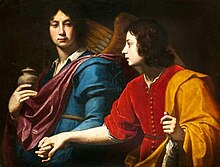Ainur in Middle-earth
The Ainur (singular: Ainu) are the immortal spirits existing
History
Origins
Before the Creation,
Valar
The
Maiar
Like the Valar, the Maiar included both good and evil characters. The Maiar were more numerous than the Valar, but less powerful individually. Among the good were the
Analysis

Norse Æsir
Critics such as John Garth have noted that the Valar resemble the Æsir, the gods of Asgard.[1] Thor, for example, physically the strongest of the gods, can be seen both in Oromë, who fights the monsters of Melkor, and in Tulkas, the strongest of the Valar. Manwë, the head of the Valar, has some similarities to Odin, the "Allfather",[2] while the wizard Gandalf, one of the Maiar, resembles Odin the wanderer.[3]
Christian angels

The theologian
Between pagan and Christian
The Tolkien scholar Marjorie Burns notes that Tolkien wrote that to be acceptable to modern readers, mythology had to be brought up to "our grade of assessment". In her view, between his early The Book of Lost Tales and the published book The Silmarillion, the Valar had greatly changed, "civilized and modernized", and this had made the Valar "slowly and slightly" more Christian. For example, the Valar now had "spouses" rather than "wives", and their unions were spiritual, not physical. All the same, she writes, readers still perceive the Valar "as a pantheon", serving as gods.[6]
Judith Kollmann wrote in Mythlore that "the Valar are clearly the gods of Scandinavia, Greece, and Rome, and, as well, the angels and archangels of Judeo-Christianity."[7]
| Middle-earth | Christianity | Classical Mythology |
Norse Mythology
|
|---|---|---|---|
Eru Ilúvatar |
The one God |
— | — |
| Ainur (Valar, Maiar) of Valinor | Archangels, Angels of Heaven | Olympian Gods |
Vanaheim
|
Manwë , a Vala |
Michael the Archangel , an Angel |
Olympian Gods |
Odin, one of the Æsir |
| Morgoth, a fallen Vala Sauron, a fallen Maia |
The Devil , a fallen Angel |
— | Loki, a fallen member of the Æsir |
Elves , etc |
— | Fauns, Satyrs, Dryads, Naiads, etc | Scandinavian folklore
|
Maiar compared to Valar
Grant C. Sterling, writing in Mythlore, states that the Maiar resemble the Valar in being unable to die, but differ in being able to choose to incarnate fully in forms such as men's bodies. This means that, like Gandalf and the Balrogs, they can be killed. He notes that Sauron's inability ever to take bodily form again after his defeat could be the result of having given his power to the One Ring, but that the fate of killed Maiar remains unclear.[8] Jonathan Evans, writing in The J. R. R. Tolkien Encyclopedia, calls the Maiar semidivine spirits, and notes that each one is linked with one of the Valar. He states that they have "perpetual importance in the cosmic order", noting the statement in the Silmarillion that their joy "is as an air that they breathe in all their days, whose thought flows in a tide untroubled from the heights to the deeps."[9][T 5] Evans notes, too, that Arien and Tilion are central in Tolkien's myth of the Sun and Moon.[9]
Luck or providence
The Tolkien scholar
In culture
In astronomy, the Kuiper belt object 385446 Manwë is named for the king of the Valar.[12]
References
Primary
- ^ Ainulindale"
- ^ Valaquenta"
- ^ Tolkien 1980, "The Istari"
- ^ Tolkien 1977, ch. 3 "Of the Coming of the Elves and the Captivity of Melkor"
- ^ Tolkien 1977, ""Quenta Silmarillion", 10. "Of the Sindar"
Secondary
- ^ ISBN 0-618-33129-8.
- ^ ISBN 978-0-8131-2301-1.
- ^ Jøn, A. Asbjørn (1997). An investigation of the Teutonic god Óðinn; and a study of his relationship to J. R. R. Tolkien's character, Gandalf. University of New England.
- ^ ISBN 978-0-664-23466-9.
- ^ ISBN 978-0-415-86511-1.
- ISBN 0-8131-2301-1.
- ^ Kollmann, Judith (1984). "Charles Williams and Second-Hand Paganism". Mythlore. 11 (2). Article 1.
- ^ Sterling, Grant C. (1997). "The Gift of Death". Mythlore. 21 (4). article 3: 16–18.
{{cite journal}}: CS1 maint: location (link) - ^ ISBN 978-0-415-86511-1.
- ^ ISBN 978-0261102750.
- ISBN 0140038779.
- ^ "385446 Manwe (2003 QW111)". Jet Propulsion Laboratory. Retrieved 16 May 2020.
385446 Manwë Discovered 2003 Aug. 25 by M. W. Buie at Cerro Tololo. Secondary (385446) I = Thorondor discovered in 2006 by K.S. Noll et al. using the Hubble Space Telescope. In J.~R.~R. Tolkien's mythology, Manwë is foremost among the deities who rule the world.
Sources
- ISBN 978-0-395-25730-2.
- ISBN 978-0-395-29917-3.
